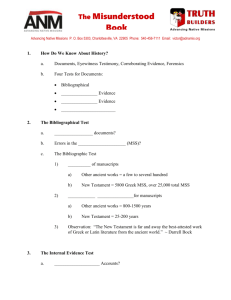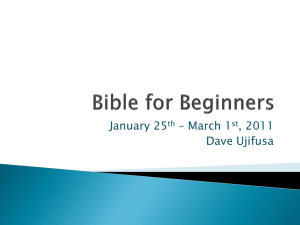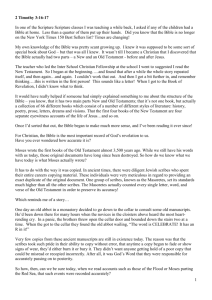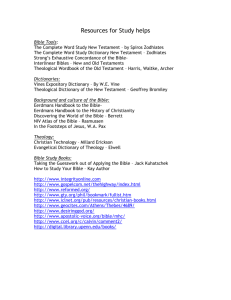Dating the Bible
advertisement
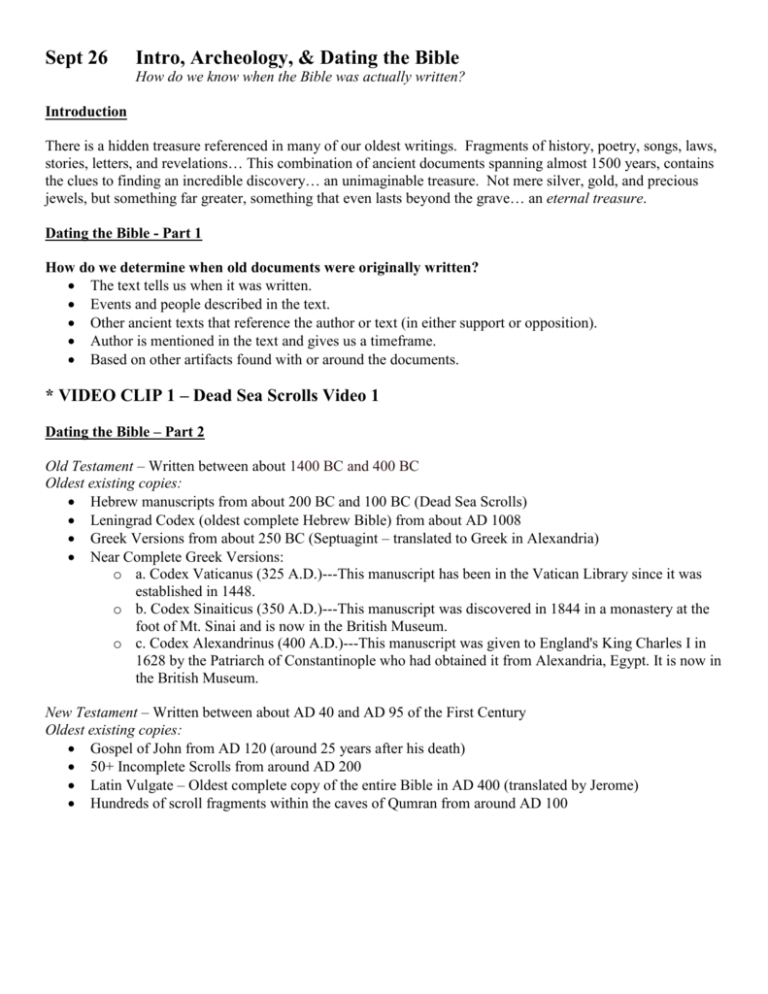
Sept 26 Intro, Archeology, & Dating the Bible How do we know when the Bible was actually written? Introduction There is a hidden treasure referenced in many of our oldest writings. Fragments of history, poetry, songs, laws, stories, letters, and revelations… This combination of ancient documents spanning almost 1500 years, contains the clues to finding an incredible discovery… an unimaginable treasure. Not mere silver, gold, and precious jewels, but something far greater, something that even lasts beyond the grave… an eternal treasure. Dating the Bible - Part 1 How do we determine when old documents were originally written? The text tells us when it was written. Events and people described in the text. Other ancient texts that reference the author or text (in either support or opposition). Author is mentioned in the text and gives us a timeframe. Based on other artifacts found with or around the documents. * VIDEO CLIP 1 – Dead Sea Scrolls Video 1 Dating the Bible – Part 2 Old Testament – Written between about 1400 BC and 400 BC Oldest existing copies: Hebrew manuscripts from about 200 BC and 100 BC (Dead Sea Scrolls) Leningrad Codex (oldest complete Hebrew Bible) from about AD 1008 Greek Versions from about 250 BC (Septuagint – translated to Greek in Alexandria) Near Complete Greek Versions: o a. Codex Vaticanus (325 A.D.)---This manuscript has been in the Vatican Library since it was established in 1448. o b. Codex Sinaiticus (350 A.D.)---This manuscript was discovered in 1844 in a monastery at the foot of Mt. Sinai and is now in the British Museum. o c. Codex Alexandrinus (400 A.D.)---This manuscript was given to England's King Charles I in 1628 by the Patriarch of Constantinople who had obtained it from Alexandria, Egypt. It is now in the British Museum. New Testament – Written between about AD 40 and AD 95 of the First Century Oldest existing copies: Gospel of John from AD 120 (around 25 years after his death) 50+ Incomplete Scrolls from around AD 200 Latin Vulgate – Oldest complete copy of the entire Bible in AD 400 (translated by Jerome) Hundreds of scroll fragments within the caves of Qumran from around AD 100 Written Process for Ancient Texts 1. The books of the Old Testament and the earliest copies of the New Testament books were laboriously copied by hand from one papyrus or leather scroll to another by scribes who were carefully trained in copying methods to ensure that there were no additions or omissions. About the 2nd century A.D., they began folding sheets of papyrus (made from a plant) or vellum (made from animal skins) in half and stitching them into a book called a codex. 2. So zealous for accuracy were the Jewish scribes that any scroll that contained errors was destroyed, rather than just corrected. Also, any scroll that became heavily worn or damaged from use was destroyed and replaced with a new copy. As a result, very few really old copies of Old Testament books have survived to the present day. Until the discovery of the Dead Sea Scrolls in 1947 in caves near Qumran, Palestine, no copies of Old Testament books produced prior to the time of Christ were known to exist. 3. We know that the Jewish copyists were extremely good at their job, because of the following: a. The Dead Sea Scrolls included scrolls of every book of the Old Testament except Esther, all copied prior to the destruction of Jerusalem in 70 A.D., many of them dating from the first and second centuries B.C. The most important of these scrolls was a leather scroll of the complete book of Isaiah which has been dated 100 to 200 B.C., hundreds of years older than any copy of Isaiah previously found! It had rested in the cave undisturbed for more than 2000 years. This copy varied from the generally accepted text of Isaiah only insignificantly. In other words. the book of Isaiah remains essentially unchanged after more than 2000 years!! b. As the Hebrew people (and later the Christians) became scattered throughout the Middle East and Mediterranean basin, families of manuscript copies developed. The text of particular books would be copied for hundreds of years by people who had little or no contact with one another. Comparison of manuscripts produced over many centuries from different geographical areas shows that the manuscripts are remarkably identical, with only very minor variations. c. Scholars have pinpointed the copyist errors in the New Testament and have found them to be insignificant, not affecting a single important fact, doctrine, or rule of faith. Eminent Greek scholar F. J. A. Hort wrote, "Apart from insignificant variations of grammar or spelling, not more than one thousandth part of the whole New Testament is affected by differences of reading." How old are the Bible manuscripts and versions? 1. Old Testament---The oldest known Hebrew manuscripts of the Old Testament were among the Dead Sea Scrolls and dated 100 to 200 B.C. The oldest complete Hebrew Bible is the Leningrad Codex from about 1008 AD in Cairo. The oldest Greek version of the Old Testament is the Septuagint, translated into Greek by Jewish scholars in Alexandria, Egypt about 250 B.C. The oldest nearly complete copies of the Old Testament in Greek are: a. Codex Vaticanus (325 A.D.)---This manuscript has been in the Vatican Library since it was established in 1448. b. Codex Sinaiticus (350 A.D.)---This manuscript was discovered in 1844 in a monastery at the foot of Mt. Sinai and is now in the British Museum. c. Codex Alexandrinus (400 A.D.)---This manuscript was given to England's King Charles I in 1628 by the Patriarch of Constantinople who had obtained it from Alexandria, Egypt. It is now in the British Museum. 2. New Testament---The earliest known manuscript fragment of the New Testament (from the Gospel of John) dates from about 120 A.D.---no more than 25 years after the death of the Apostle John. About 50 other fragments are dated less than 200 years from the date of their original writing. 3. The oldest nearly complete version of the Bible in Latin is the Latin Vulgate(400 A.D.)---The scholar Jerome translated the Bible into Latin about 400 A.D. and it became the Bible of the Roman Catholic Church for more than 1000 years. How does the age and quantity of Bible manuscripts compare to other ancient writings? 1. Compared to the amount of other ancient writings in existence, the Bible has more manuscript evidence supporting its reliability and accuracy of translation than all other classical writings combined. In particular, the New Testament manuscripts also stand apart from other ancient literature in regard to their close proximity to the time of original composition. a. Caesar's Gallic War (written 58 to 50 B.C.)---There are only ten good copies, and the oldest was made 900 years later than the original! b. The Roman History by Livy (59 B.C.-17 A.D.)---Only 35 of the 142 volumes in this history still exist, in a total of 20 manuscripts. The oldest is from the 4th century A.D. c. The Histories of Tacitus (100 A.D.)---Of the 14 volumes, only four and ahalf have survived. Of the 16 volumes of his Annals, only 10 survive. These come down to us in only one manuscript each, one from the 9th century A.D. and the other from the 11th century A.D. ---700 to 900 vears after they were written! d. The History of Thucydides (460-400 B.C.)---Only eight manuscripts survive, the oldest about 900 A.D., except for a few papyrus scraps from the 1st century A.D. The complete manuscripts are from 1300 years after they were written! e. The Plays of William Shakespeare ---In every one of Shakespeare's 37 plays, there are probably a hundred passages still in dispute as to their original text, a large portion of which materially affect the meaning of the passages in which they occur. (Not so, the New Testament, written 1500 years before Shakespeare was born!) 2. Eminent scholar F. F. Bruce wrote, "If we compare the present state of the New Testament text with that of any other ancient writing, we must . . . declare it to be marvelously correct. Such has been the care with which the New Testament has been copied---a care which has doubtless grown out of a true reverence for its holy words ---such has been the providence of God in preserving for His Church in each and every age a competently exact text of the Scriptures, that . . . the New Testament (is) unrivaled among ancient writings in the purity of its text as actually transmitted and kept in use. . . . The evidence for our New Testament writings is ever so much greater than the evidence for many classical authors, the authenticity of which no one dreams of questioning. And if the New Testament were a collection of secular writings their authenticity would generally be regarded as beyond all doubt." Other Old Documents Author Book Date Written Earliest Copies Time Gap Homer Herodotus Thucydides Plato Demosthenes Caesar Livy Iliad History History 800 BC 480-425 BC 460-400 BC 400 BC 300 BC 100-44 BC 59-17 AD C. 400 BC C. 900 AD 900 AD 900 AD 900 AD 900 AD 4th Century (Partial), Mostly 10th Century 400 years 1350 years 1300 years 1300 years 1300 years 1000 years 400 years No. of Copies 643 8 8 8 7 10 1 partial 19 copies 20 7 5366 Tacitus Pliny Secundus New Testament Gallic Wars History of Rome Annals Natural History 100 AD 61-113 AD 1100 AD 850 AD 1000 years 1000 years 750 years 50-100 AD 114 Fragments 200 (Books) 250 (Most NT) 325 (Complete NT) 50 years 100 years 150 years 225 years Our countries oldest document… Declaration of Independence – 1776 (it resides in the National Archives today)

